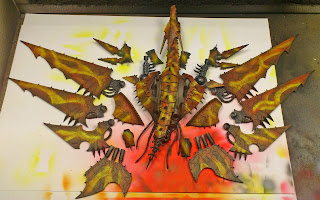The model hat been put together with a weird, forward leaning stance and a horizontally held glaive, which I set out to correct. I broke the hip joints, a knee and the ankles to reposition the model's right leg forward, using 2mm thick nails as pins in lieu of the now destroyed plastic locking pins.
The wrist with the sword I sawed off and then re-attached with magnets, making it freely positionable. I was quite happy with the result, until someone pointed out a mistake I made when it was way too late to correct it without basically starting over. Bonus points if you spot it. ;-]
The base looked a bit bleak and empty. I didn't want to do something too complicated, but adding some decoration seemed the way to go. Since Worldship Iyanden was almost wiped out by Swarm Kraken, I figured some Tyranid and Eldar casualties on the base would fit.
I got some Nid-fodder, which turned out to work great, since two legs are plugged into the body and could therefore fold nicely. I just slashed down a messed up guardsman to keep them company. Since I didn't want to fiddle with the casualty positions between the wraithknights feet, I glued the casualties up on thin plastic sheet, which I cut out rounded to no straight lines would stick out. I added some gravel to the base to round it out.
Since the original black primer coat had been damaged with the changes and some scraping and sanding, I had to reprime the model. I used black Vallejo Airbrush Primer. Since that would make applying yellow a nightmare, I then followed that up with a coat of Vallejo Model Air Light Grey. It turns out that the grey Vallejo primer is a bit lighter and not really rougher than the black primer. So I'd use that - or even the white primer for more Iyanden models.
For the yellow, I tested VMA Medium Yellow, VMA Gold Yellow and Citadel Yriel Yellow on a base coated with black primer and stripes of white, light grey and dark grey. While VMA Medium Yellow on White gives a good result, the Yriel Yellow (thinned of course) did look very convincing indeed, so I went with that.
Here is the miniature (HA!) with the yellow basecoat. In retrospect, applying the yellow base colour first was a bad idea. I should have applied the other colours first and then masked those areas. That way the yellow can go over the whole thing and there is no risk of spilling constrasting colours on the yellow when brushing in recesses. Since the model was completely glued up and has many protuding bits, there was quite some awkward brushwork, bad accessability and bad visibility in play here. Lesson learned. Boy am I happy that my wraithknight has a ton of magnet joints improving accessability to no end in comparison!
Here is the model with the dark grey and blue applied. Glaive and gems left to do.
Here is the glaive with conventional (non purple) power shading and the gems done. The gems I painted with McCragge, Aliatoc and Hoeth blue, following the Eldar release White Dwarf tutorial for having a dark spot on the top and a diagonal colour gradient to the gem colour. I added Tamiya Clear Blue as Glaze and added two small highlight points using Ceramite White and a toothpick.
Seeing the amount of natural shadows on the model, I was quite reluctant to attempt manual brush highlights on the model or trace the lines between the armour plates. Since this model wasn't mine, I didn't want to mess it up. I'll now use the experience I gained to deal with my own wraithknight. When that one is done, I'll most likely come back to this one to share the love.
My plan of action for my wraith knight is the following:
- Vallejo Airbrush Primer in Grey.
- Airbrush face shield very light grey to white, mask with liquid mask.
- Airbrush joints dark grey, mask them with tape.
- Airbrush gems, mask them with liquid mask.
- Airbrush blue armour parts, add colour gradient, mask with tape.
- Re-prime around the masks to cover overspray.
- Airbrush Yriel Yellow, add Flash Glitz yellow highlight by spraying from above.
- Very very carefully remove all the masking stuff.
- Touchup.

















